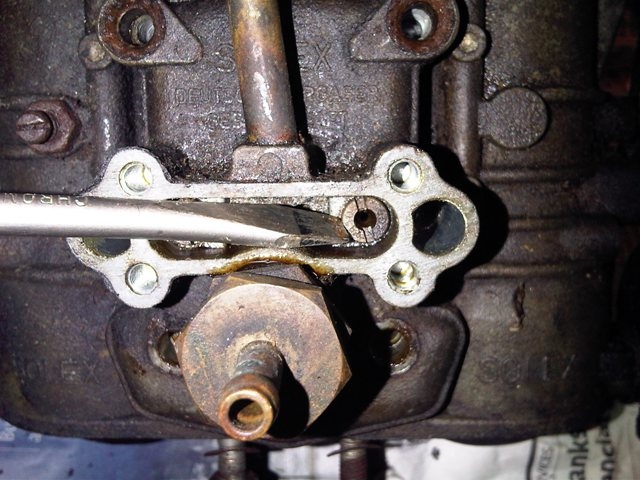Weber tuning tips only go so far with Solex PHHs, but basic balancing crosses over. This is a nice write up from the MB forums for the 44PHH...there are differences mind you, but good pictures and tips. http://www.190slgroup.com/tech/solex adj procedure.pdf
I have personally never used a Unisyn synchronizing tool, but I have never heard many good things about them... I have good success using the squirrel cage style for PHHs. For carbs with vacuum ports, a manometer is the only way to go (this 40PHH does not have vacuum ports, though). Try synchronizing at about 2000 rpm and see if your results vary after you back the idle back down.

Couple things on high idle... is the throttle return spring pulling both carb's throttle all the way shut? Can you close the throttles levers by hand and lower the rpm? I occasionally have my linkage get lazy and one carb is slow to return to fully closed... causing a high idle. Any slop in the linkage can cause this issue. You can use a small hand mirror and a bright flashlight to look into the carb's throat to inspect if the throttle butterflies are seated equally.
Remove the idle mix screws completely and check that the needle-ends are smooth. It is possible to damage the needles by forcefully seating them. If the needles are marred, it could affect idle speeds.
Are you sure that each carb is jetted equally (same # on all the idle jets, especially?) Your discrepancy between one carb and the other's mixture screws leads me to think the idle jets may be different. The #s are the top of the idle jet at the screw slot (my old eyes won't let me read the #s without removing them, perhaps you can use the zoom feature on your smart phone camera)
Are you positive there are no vacuum leaks? With the engine at idle, spray carb cleaner directly at the throttle rod "bushings"... these are the worst culprits for air leaks on PHHs. If you find the engine bogs after spraying the throttle "bushings", I've had good success in sealing minor leaks with simple axle grease applied to the bushing area with a Q-tip, or long, skinny screwdriver. Vacuum will pull the grease into the void and help seal off the leak.
The fuel level is adjusted at the fuel inlet. The inlet has a brass jamb-nut that you loosen and then screw in/out the top "nut" to adjust the needle seat against the float lever within the carb. Check to see that each carb has the same amount of gap between the inlet and the jamb-nut (it's only a couple mms)
You set the timing... what is the timing at idle? Timing will certainly affect idle speed. Haynes manual for a BMW 2002Ti (same engine) shows 18-22 degrees at 1000rpm.
Hope this helps,
Ed
I had to look, I never realized the UniSyn was its own tool, I just thought that was sort of a catch-all term for these flow meters. The one I've been using looks just like that picture you posted, so at least I'm good there. I'll have to try syncing them at 2000 RPM to see if that does anything for me, I've been doing it at 1200 RPM.
I've tried pulling the throttle lever (on the carburetor) as closed as I possibly can, no dice. The springs seem to be doing a good enough job holding everything closed. Last week I took the carbs off the car to check the position of the butterflies, and, after some adjustment, they all seemed fine. There's still a tiny bit of light visible around the plate, but I don't think I can get rid of that completely. The needles were replaced as part of the rebuild, but I have removed them and they all seem to be in good shape with no marring or bending or anything. The idle jets are all the same, but I don't remember off the top of my head what number they are. I tried zooming in, but my phone camera doesn't have the resolution for that, I'll have to look when I go home. I'm pretty sure there aren't any vacuum leaks. I didn't have any carb cleaner handy but I held a propane torch (not lit, just the gas flow) around the carbs and didn't notice any idle up or anything. I'll try again though and focus on the throttle rod bushings.
The float level is the one thing I haven't played with yet, so I think I'll have to give that a look when I pull the car out again. Do you know what the level is supposed to be?
Not sure what the timing is at idle. I set it using the directions I got from @starcruiser in the post I linked to in the OP, 25° BTDC @ 2000RPM. Unless I graduate the crank pulley it's going to be hard to tell where I am. Then there's the problem of getting the engine to idle down to 1000RPM...
Thanks for your help so far. Hopefully I'll get this thing sorted. It really doesn't seem all that complicated, but it sure is finicky.

